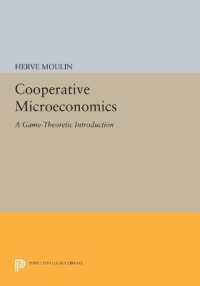- ホーム
- > 洋書
- > 英文書
- > Science / Mathematics
Full Description
Earth-like Exoplanets, Volume Three reviews the rapidly expanding study of exoplanets and what these new worlds have revealed regarding planet types located in diverse circumstellar and planetary environments. Currently, Earth remains the only example for life on planets, but other Solar System bodies - Venus, Mars, and the Moon - provide important information about where and when life is possible. As life on Earth and the lack of detected life on bodies in, or near, the habitable zone of the Sun supply much of what is directly known about astrobiology, the possibilities of finding life out there is ripe for new discovery.
Contents
Exoplanets - What Have We Found and What is on the Horizon? 1. Kepler's Planet Discoveries and Beyond 2. Tess Planet Finder for Nearby StarsHabitability of Exoplanets 3. Updated Habitable Zone Definitions 4. The abundance of non-water seas in rocky worlds 5. The Binary Habitability MechanismDetection of Biomarkers vs. False Positives 6. Can lightning spectra be a biomarker for Earth-like exoplanets? 7. Detectability of open seas and their reflection spectra on exoplanets 8. Challenges of reading biomarkers from exoplanet atmospheres during transitsThe Origin of Organic Matter and Life, In-situ or Panspermia? 9. A survey of solar system and galactic objects with pristine surfaces that record history and perhaps panspermia, with a plan for exploration 10. Panspermia: A panoply of possibilitiesExtremophiles - Alternate Evolutionary Pathways 11. Can there be a Rogue Earth? 12. Comparison of the multidimensional niches inhabited by Earth extremophiles with the multidimensional spectrum of exoplanetsLife on Exoplanets over Cosmic Time 13. Habitable and super-habitable exoplanets







